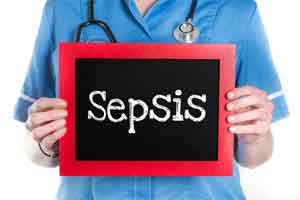- Home
- Editorial
- News
- Practice Guidelines
- Anesthesiology Guidelines
- Cancer Guidelines
- Cardiac Sciences Guidelines
- Critical Care Guidelines
- Dentistry Guidelines
- Dermatology Guidelines
- Diabetes and Endo Guidelines
- Diagnostics Guidelines
- ENT Guidelines
- Featured Practice Guidelines
- Gastroenterology Guidelines
- Geriatrics Guidelines
- Medicine Guidelines
- Nephrology Guidelines
- Neurosciences Guidelines
- Obs and Gynae Guidelines
- Ophthalmology Guidelines
- Orthopaedics Guidelines
- Paediatrics Guidelines
- Psychiatry Guidelines
- Pulmonology Guidelines
- Radiology Guidelines
- Surgery Guidelines
- Urology Guidelines
Managing Sepsis with hypovolemia: Expert Statement

Hypovolemia is frequent in patients with sepsis and may contribute to the worse outcome. The management of these patients is delayed by the low quality of the evidence for many of the specific components of the care.
Sepsis is a life-threatening condition that arises when the body's response to infection causes injury to its own tissues and organs and Hypovolemia defines state of decreased blood volume speciafically decrease in volume of blood plasma.
Evidence surrounding fluid resuscitation in hypovolemic sepsis is mostly weak, except that for avoiding hydroxyethyl starch, transfusing at Hb ≤7 g/dL.
Aggressive fluid resuscitation can be harmful, especially if continued after circulatory status fails to improve.
A consensus statement by 6 university-based coauthors, 4 having widely published in sepsis; the lead author was invited by journal board to discuss recent advances and controversies in this field and give expert statements for the management of hypovolemia in patients with sepsis including triggers and targets for fluid therapy and volumes and types of fluid to be given.
The recommendation is published in the journal Intensive Care Medicine.
Following are the Key recommendations:
The recommendation is published in the journal Intensive Care Medicine.
Following are the Key recommendations:
- Fluids:
- Use small, repeated crystalloid boluses; stop if circulation fails to improve, and if it stabilizes, fluid-restrict.
- Do not use hydroxyethyl starch, gelatine, dextran (higher certainty).
- Vasopressor:
- Consider early norepinephrine if severe hypotension, no response to bolus.
- Peripheral large-vein administration may be acceptable for the limited time.
- Monitoring:
- Repeatedly check BP, heart rate, lactate, temperature, mottling; if normal, additional fluids may not help; if worsening, fluids may harm.
- Amid worsening or unexplained shock, consider echocardiography or cardiac output measurement.
- Prerequisites to use fluid-responsiveness tests: arterial waveform analysis requires sinus rhythm and mechanical ventilation with tidal volumes >7 mL/kg, deep sedation; passive-leg-raising test requires assessment of stroke volume changes.
- Consider reducing propofol (Diprivan), remifentanil (Ultiva), dexmedetomidine (Precedex), epidural anesthesia, which can worsen shock.
- Transfuse at Hb ≤7 g/dL (4.3 mmol/L) or higher if myocardial ischemia (higher certainty).
Importance of new consensus
- Multiple fluid-related recommendations in 2016 Surviving Sepsis Campaign (SSC) guideline rest on weak evidence.
- ProCESS, ARISE, and ProMISe failed to confirm the benefit of early goal-directed therapy.
- Insufficient data regarding:
- Triggers for fluid resuscitation;
- Boluses vs infusion;
- Higher vs lower volumes;
- Saline vs buffered crystalloids;
- Lactate- vs acetate-buffered solutions;
- Albumin;
- Early peripheral norepinephrine
The recommendation is published in the journal Intensive Care Medicine.
For further reference log on to :
Perner, A., Cecconi, M., Cronhjort, M. et al. Intensive Care Med (2018). https://doi.org/10.1007/s00134-018-5177-x
crystalloid bolusesdexmedetomidinedextranDiprivangelatineguidelinehydroxyethyl starchhypotensionhypovolemialactatelow blood volumelow circulatory volumemottlingnorepinephrineProCESSremifentaniresuscitationsepsissepticemiaTransfusewaveform
Source : With inputs from Intensive Care MedNext Story
NO DATA FOUND

Disclaimer: This site is primarily intended for healthcare professionals. Any content/information on this website does not replace the advice of medical and/or health professionals and should not be construed as medical/diagnostic advice/endorsement or prescription. Use of this site is subject to our terms of use, privacy policy, advertisement policy. © 2020 Minerva Medical Treatment Pvt Ltd